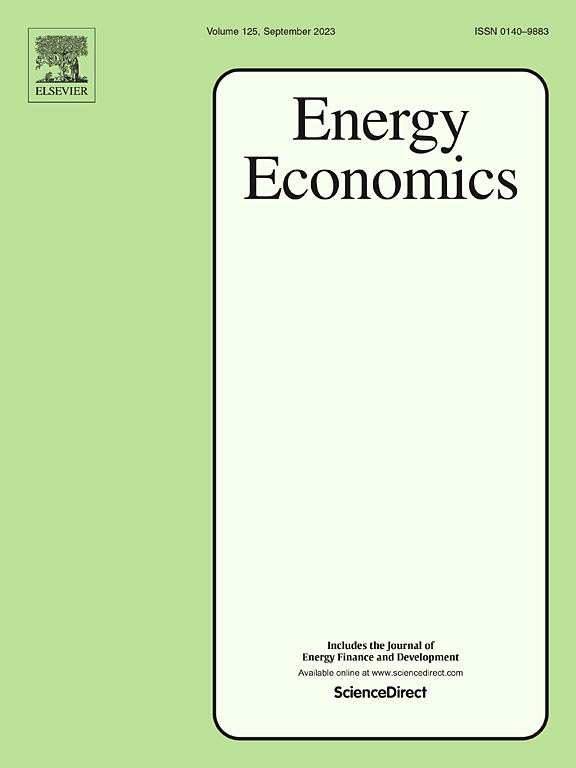Understanding the role of socio-economic, demographic, environmental, infrastructural, and institutional attributes in the uptake of biogas technology in Pakistan: Proposing and implementing a novel step-wise framework
IF 14.2
2区 经济学
Q1 ECONOMICS
引用次数: 0
Abstract
The extant literature considers the uptake of biogas technology as a remedy to mitigate the energy deficiency in rural areas; however, most of these considerations are based on either techno-economic or willingness-to-pay analyses for renewable energy at an arbitrarily chosen site, ignoring several important things that are necessary to consider in the first place. Other issues include linking the success of biogas projects with government subsidies, which is unlikely in most cases as energy-deprived countries are also facing economic problems. Thus, this study first proposes and then implements a framework that indicates the importance of (i) observing demographic, socio-economic, institutional, environmental, and infrastructural factors at household levels and (ii) site selection criteria for the successful enactment of biogas technology in rural communities. In doing so, we collected data from 469 households across three distinct regions of Pakistan—Khyber Pakhtunkhwa, Punjab, and the Federally Administered Tribal Areas—that met our selection criteria. By employing the probit model, we first pinpoint the determinants for biogas adoption decisions, followed by factors influencing the likelihood of households' willingness (decision) to adopt (discontinue) biogas technology. Socio-economic and infrastructural (demographic and institutional) attributes are the most (least) promising factors influencing biogas technology adoption. Based on the treatment effect and discussions with the participants, we find that households aware of the benefits associated with biogas technology in mitigating energy needs and improving socio-economic conditions are more willing to adopt it. From the policy standpoint, we suggest implementing a biogas promotion program by providing technical assistance to households and integrating it with sugar mills (for bagasse), irrigation and horticulture offices (for crop residuals and water), and municipal committee offices (for waste management); it possibly will help in accelerating the uptake and sustainability of biogas energy sector in Pakistan without relying on subsidies or credit facilities.

了解社会经济、人口、环境、基础设施和制度属性在巴基斯坦采用沼气技术中的作用:提出并实施一个新的分步框架
现有文献认为沼气技术的吸收是缓解农村地区能源短缺的一种补救措施;然而,这些考虑大多是基于对任意选择地点的可再生能源的技术经济或支付意愿分析,而忽略了一些首先需要考虑的重要因素。其他问题包括将沼气项目的成功与政府补贴联系起来,这在大多数情况下是不可能的,因为能源匮乏的国家也面临着经济问题。因此,本研究首先提出并实施了一个框架,该框架表明了以下两点的重要性:(1)观察家庭层面的人口、社会经济、体制、环境和基础设施因素;(2)在农村社区成功实施沼气技术的选址标准。在此过程中,我们收集了位于巴基斯坦三个不同地区的469户家庭的数据,这些地区属于符合选择标准的KP、旁遮普和FATA地区。通过采用probit模型,我们首先确定了采用沼气决策的决定因素,然后确定了影响家庭采用(停止)沼气技术意愿(决定)可能性的因素。社会经济和基础设施(人口和体制)属性是影响沼气技术采用的最有(最没有)希望的因素。根据处理效果和与参与者的讨论,我们发现,意识到沼气技术在缓解能源需求和改善社会经济条件方面的好处的家庭更愿意采用它。从政策角度来看,我们建议实施沼气推广计划,向家庭提供技术援助,并将其与糖厂(甘蔗渣)、灌溉和园艺办公室(作物残留物和水)以及市政委员会办公室(废物管理)相结合;它可能有助于在不依赖补贴或信贷设施的情况下加速巴基斯坦沼气能源部门的吸收和可持续性。
本文章由计算机程序翻译,如有差异,请以英文原文为准。
求助全文
约1分钟内获得全文
求助全文
来源期刊

Energy Economics
ECONOMICS-
CiteScore
18.60
自引率
12.50%
发文量
524
期刊介绍:
Energy Economics is a field journal that focuses on energy economics and energy finance. It covers various themes including the exploitation, conversion, and use of energy, markets for energy commodities and derivatives, regulation and taxation, forecasting, environment and climate, international trade, development, and monetary policy. The journal welcomes contributions that utilize diverse methods such as experiments, surveys, econometrics, decomposition, simulation models, equilibrium models, optimization models, and analytical models. It publishes a combination of papers employing different methods to explore a wide range of topics. The journal's replication policy encourages the submission of replication studies, wherein researchers reproduce and extend the key results of original studies while explaining any differences. Energy Economics is indexed and abstracted in several databases including Environmental Abstracts, Fuel and Energy Abstracts, Social Sciences Citation Index, GEOBASE, Social & Behavioral Sciences, Journal of Economic Literature, INSPEC, and more.
 求助内容:
求助内容: 应助结果提醒方式:
应助结果提醒方式:


